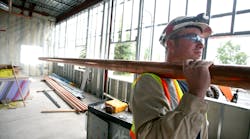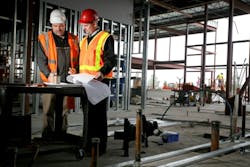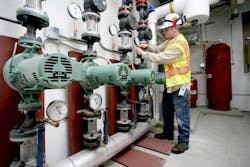ANCHORAGE, ALASKA — On Joint Base Elmendorf Richardson (JBER), near Anchorage, Alaska, construction is booming like the sound barrier being shattered. The USAF’s 3rd Wing is stationed at JBER, ready to deploy at a moment’s notice. The unit includes F-22 Raptors: the world’s most advanced stealth fighter aircraft.
Before the Air Force’s elite pilots get actual air time in a Raptor, they must undergo hundreds of hours of classroom instruction and training specific to that aircraft. The pilots receive final training at JBER’s newly-constructed F-22 Flight Simulator Facility.
The 23,000-sq.ft. facility is one of two new buildings on the base. The other is the new Professional Military Education Center (High flying heat
Average January temperature on JBER is 15°F, with lows dipping below -20°F. Like most heating systems there, in a state that takes the need for mid-winter heat pretty seriously, the hydronic systems were built with high performance in mind.
“Our design temperature for both buildings is -20°F,” saidTroy Nibert and Steve Nazaroff review plans for the F-22 Flight Simulator building.
“The design on the buildings started in 2008,” said Nazaroff. “It was challenging to get the Government to accept the plans for a heating system they’d never seen before.” Weldin finally received approval to install the Taco LoadMatch systems.
LoadMatch consists of a new technology complementing two common systems: single pipe distribution and primary-secondary pumping. The new technology utilizes maintenance-free wet rotor circulators. The primary distribution system is a single pipe loop; the secondary distribution system is a decoupled secondary piping loop for each unit in the system.
The new system replaces all the expensive and energy-consuming control valves and most balancing valves found on a traditional hydronic system, with small, low kW circulators. The circulators deliver the water where it needs to go, instead of forcing the water to go where it isn’t needed. The savings in raw material, installation costs, and energy consumption are substantial.
“It’s self-balancing, reducing many start-up, commissioning and operational problems, since all zones get their required amount of flow at all times,” said Nazaroff.
In addition to energy savings and efficient heat distribution typical of hydronic systems, LoadMatch reduces head loss by eliminating many control and balancing valves, and a considerable amount of pipe. The result is lower pump head and less energy consumption to move the water.
One of the experts eager to see the mechanical solution include LoadMatch was“Troy and I really had to push to convince the government to go with the LoadMatch system,” said Nazaroff. “It was something new, they’d never heard of it. We pushed because we believe in the system, and we knew that it would exceed their requirements.”
In both buildings, heat travels through a heavily-insulated, three-inch main mounted in mechanical mezzanines throughout the single-story facility. With the aid of the LoadMatch circulators, the big main supplies VAV boxes, baseboard, and single fan coil units through three-quarter or one-inch secondary piping. “Installing only one main line, as opposed to a separate supply and return, saves copper, and lots of time,” said Nazaroff.
At the source
Two 800 MBH gas-fired boilers by Burnham are the BTU source for the F-22 Flight Simulator Facility. From the large boilers, water travels through the three-inch main out into the building. At most of the terminal units, three-quarter inch lines tee off. The VAV boxes are supplied by one-inch lines. “The units in the simulator bays use one-inch lines,” said Nazaroff.
Weldin Construction’s foreman tightens a pressure gauge.
The simulator bays are 60 feet long, 25 feet wide, and 27 feet high. Overhead doors seal each bay off. Inside is a mechanical and electrical marvel: a Boeing F 22 flight simulator. Each machine is positioned on hydraulic stilts, allowing the pilot to experience maneuvers like real flight.
At the“One challenge that we had at JBER was security,” said Nazaroff. Once Weldin trucks were identified, background checks on technicians completed, and ID tags distributed, getting on and off base was not an issue. Rather, penetrating building envelopes caused problems.
The security system being installed in the F-22 Flight Simulator building required that no conductive material be used to pass through the foundation or walls of either facility. Polypropylene pipe had to be use for coolant, gas and electric lines.
The buildings were both insulated with R19 batting in the walls, and R30 rigid insulation in the roof. The exception is the huge simulator bays, where R22 insulated metal panels were used to form the walls.
Liquid cooled
Although Alaskan summers can get a little humid, uncomfortably hot conditions are rare. June of 1985 saw a record-setting high of 85°F, but the summer average is 56°F. The cooling systems’ design temp is 70°F, which seems insignificant, but the real load on the chiller and air conditioners comes from the heavy computer infrastructure found inside the buildings.
“There’s a Multistack, 60-ton chiller at the Simulator building, piped to large cooling coils which provide space cooling,” explained Nazaroff. “Communication and server rooms have additional cooling provided by Liebert computer room cooling units. These are also piped to the chiller.”
“We finished work at theResisting change
“Although the LoadMatch system was the main reason we were able to finish the projects on time, in the beginning it was a real uphill battle with government officials getting the system approved,” said Nazaroff.
“Apparently, there’s a nightmarish story about another single-pipe system at JBER that another contractor installed 20 years ago,” explained Nazaroff. “After being re-assured by Greg Cunniff, application engineering manager at Taco, that the failed system was a completely different design, we moved forward with LoadMatch.
“I’ll use LoadMatch wherever I can,” said Nazaroff. “It’s better for the customer, better for the contractor, and in the end it just means fewer headaches for me. The



